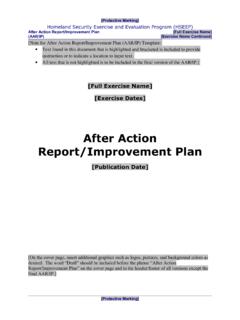Transcription of CMP-24EDIT2(13July04).doc 8 Chemicals from water …
1 CMP-24 EDIT2(13 July04).doc 558 Chemicals from water treatment and distribution Introduction Chemicals from water treatment and distribution reach drinking- water by the most direct route . They fall into three broad categories: substances resulting from the addition of Chemicals used in the treatment process for coagulation and disinfection these Chemicals are intentionally added and can give rise to residues or by-products; disinfectants that are deliberately added with the intention of maintaining a residual in distribution , usually to the tap these Chemicals may also give rise to by-products.
2 Substances that leach from materials used in distribution or plumbing, or that arise from the corrosion products of pipes. The WHO Guidelines for Drinking- water Quality (WHO, 2004) cover a significant number of potential substances from water treatment or distribution (summarized in Table ), but only a few of these substances are of practical significance. It is important that water supply agencies properly manage any Chemicals that they use. In many cases, the best method of control is through management practices, such as optimization of the treatment process, and regulation of materials and Chemicals that come into contact with drinking- water , rather than through monitoring and chemical analysis.
3 This chapter gives guidance on the importance of potential Chemicals derived from water treatment or distribution , from a management perspective. Chemicals used in treatment Disinfectants and disinfection by-products The three Chemicals most commonly used as primary disinfectants are chlorine, chlorine dioxide and ozone. Monochloramine, usually referred to as chloramine, is used as a residual disinfectant for distribution . Chlorine Chlorine is the most widely used primary disinfectant and is also often used to provide residual disinfection in the distribution system.
4 Monitoring the level of chlorine in drinking- water entering a distribution system is normally considered to be a high priority (if it is possible), because the monitoring is used as an indicator that disinfection has taken place. Residual concentrations of chlorine of about mg/l or more may cause problems of acceptability for some consumers on the basis of taste. Monitoring free chlorine at different CMP-24 EDIT2(13 July04).doc 56points in the distribution system is sometimes used to check that there is not an excessive chlorine demand in distribution that may indicate other problems in the system, such as ingress of contamination.
5 Chlorine reacts with naturally occurring organic matter in raw water to form a range of unwanted by-products. Guideline values have been established for a number of these by-products. The compounds most widely considered as representatives of chlorination by-products for the purposes of setting standards and monitoring are the trihalomethanes (THMs) which include chloroform, bromodichloromethane, chlorodibromomethane and bromoform. Haloacetic acids (HAAs), such as monochloroacetate, dichloroacetate and trichloroacetate, can also be formed as the result of reaction of chlorine with organic matter contained in raw water .
6 Some countries monitor HAAs as well as THMs, but HAAs are much more difficult and expensive to analyse than THMs. THMs and HAAs continue to develop within the distribution system; thus, monitoring can be complex. Optimizing coagulation and filtration is most important in helping to remove the precursors of these by-products and will, in turn, reduce the formation of THMs, HAAs and other unwanted by-products. In order to ensure the microbial safety of drinking- water , disinfection should never be compromised in trying to meet guidelines for any disinfection by-products.
7 Chlorine dioxide Chlorine dioxide breaks down to leave the inorganic Chemicals chlorite and chlorate. These are best managed by controlling the dose of chlorine dioxide applied to the water . Chlorite can also be found in hypochlorite solution that has been allowed to age. There is no guideline value for chlorate because of limited data on its toxicology, but this chemical has been shown to be less toxic than chlorite and is present at lower concentrations. Controlling chlorite will generally also adequately control chlorate.
8 Ozone Ozone, used as a primary disinfectant, cannot be monitored in drinking- water , because it leaves no residual. Ozonation in the presence of inorganic bromide, which can occur naturally in raw water , can give rise to low concentrations of bromate. The analysis of bromate is difficult and expensive, because a number of other inorganic substances that interfere with the analysis may be present. It is considered, therefore, that bromate monitoring is a low priority, and that management should instead involve controlling the conditions of ozonation.
9 Monochloramine Monochloramine, used as a residual disinfectant for distribution , is usually formed from the reaction of chlorine with ammonia. Careful control of monochloramine formation in water treatment is important to avoid the formation of di- and trichloramines, because these can cause unacceptable tastes and odours. The formation of nitrite as a consequence of microbial activity in biofilms in the distribution system is a possibility when monochloramine is used as a residual disinfectant, particularly if ammonia levels are not sufficiently controlled.
10 CMP-24 EDIT2(13 July04).doc Coagulants Coagulation and flocculation are important barriers to microbiological contaminants and are key processes for reducing naturally occurring organic matter and turbidity, which can seriously affect the efficiency of disinfection. Chemicals used as coagulants in drinking- water treatment include aluminium and iron salts, such as aluminium sulfate, polyaluminium chloride or ferric sulfate. No health-based guideline values have been set for aluminium and iron, because neither is considered to be of significance to health when used under normal circumstances in water treatment .











